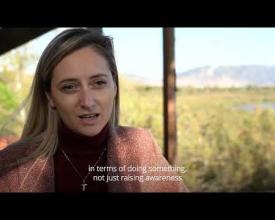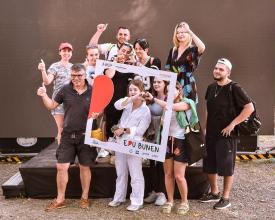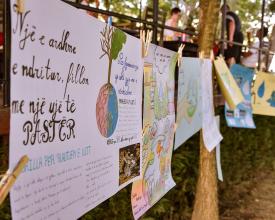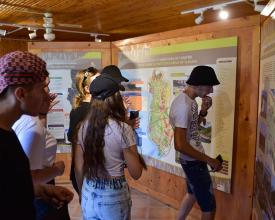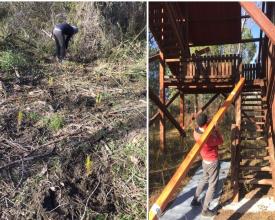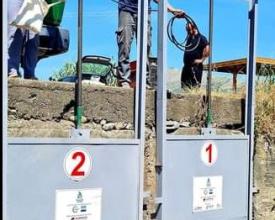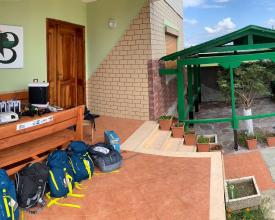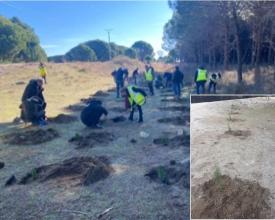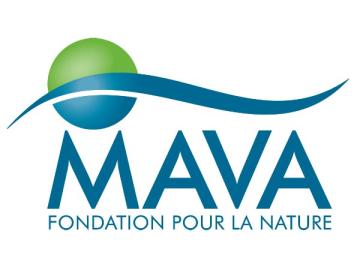
Increasing Community Contribution to the Buna Delta
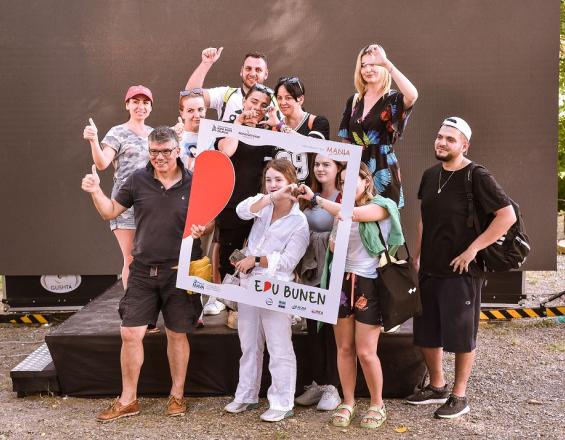
The Buna River Velipoje Protected Landscape (BRVPL), in north-western Albania, spans over 20,000 hectares, encompassing the Viluni lagoon, Buna River, and the gulf of Drini running alongside the Adriatic Sea. The site is designated as a protected area, and under the Ramsar Convention as a wetland of international importance. The landscape is home to threatened endemic bird and plant species and is an important migration corridor between the Adriatic Sea and inland areas.
The area has about 30,000 residents, with activities such as agriculture, livestock, fishing and tourism. There is an increasing awareness among people to protect and preserve the natural wealth of the landscape, however local practices and priorities continue to threaten the natural values.
The solution is to deliver activities that increase the ideas and capability in the community to contribute to protection and management of the protected landscape.
Context
Challenges addressed
Most of the damage to the protected landscape in Buna is from tourism, agriculture and day-to-day activities that are not supported by sustainable methods or infrastructure. The encroachment upon the area by new development and practices directly destroy flora and fauna and pollute land and water.
Economically, the community loses over time when natural resources are lost, however this is not apparent financially in the short term, and decisions are made based on the immediate financial need.
There is a clear social concern that big businesses often develop and destroy the land, while other members of the community do not have fair access to resources. These people who are local and have a respect for the natural values in their area are more likely to be interested in smaller business or more sustainable uses, but do not have the resources to develop competitive initiatives. The result is a battle, where people feel they must choose between their livelihoods and the environment.
Location
Process
Summary of the process
The inclusion and sequence of the building blocks is very important for the quality of the outcomes.
The training sessions are critical as the basis for a new grant program, especially when grantees are inexperienced. It ensures that they know about the process for applying for a grant, and what their project should focus on and achieve. The training sessions on policy and strategy, local priorities and applying for grants have the benefit that they give community the tools to apply for future grants and funding opportuntites, after the completion of the current project.
The grant program enables people to set up sustainable initiatives or improve existing practices, and improve monitoring and reporting skills. Additionally, it can be used to make useful new connections within the community and with project partners, bigger organisations, government representatives and donors.
Initiating an additional opportunity towards the end of the grant programme, in this case the Buna Day fair, is beneficial to give the grantees an opportunity to take the lead in running an event that conributes to a broader event, and for some to provide professional services.
Building Blocks
Community and CSO Training program
The training sessions targetted community members and CSOs, and aimed to provide the basis for them to be able to develop and propose project ideas effectively.
As the objective was for collaborative protection and management of the protected landscape, the management plan for the Buna River protected area was the first topic, for a shared understanding of the plan and local management objectives.
Secondly, the focus was on threats to the natural values - which helped participants understand what they could focus efforts on to have the most positive impact.
An upcoming grant program was then introduced, and a session held on how to develop project ideas and apply for grants that aligned with the call. Some key environmental issues in the area, plus key activities in the management plan were highlighted.
Enabling factors
1. Funding for training program
2. Understanding of the position and existing knowledge, plus knowledge gaps of the target audience
3. People who want to be involved through community action
4. An existing endorsed management plan to ensure alignment of community actions with those undertaken by responsibilities
Lesson learned
The grant program was run twice, and the first time there was no introductory training. The second call had preparatory workshops, where we guided the topics and helped projects ensure alignment with the management plan actions. The quality of the applications was much higher in the second call.
Small Grant program
The small grant program was a financial mechanism to allow ideas to be developed into projects that benefit the environment and local people. It allowed community members to demonstrate that sustainable tourism, agriculture, water management and recreation were feasible and how they benefit the area.
Both individuals and NGOs were given the opportunity to apply for grants up to EUR 20,000 for local initiatives. Prospective grantees were given guidelines, including the requirement that the proposal implemented objectives or activities of the management, especially in priority areas. The grantees also were required to consult with the authority for protected areas, who are responsible for the management of the Buna River Velipoje protected landscape.
A panel consisting of project partners and local authorities worked together to assess and decide on successful grants.
For the final activity of a secondary Buna project, which focussed on youth and community engagement, we brought together the grantees to take the lead in running a weekend of community events to celebrate the nature of Buna. The events included a media tour for ecotourism, a concert on the river and a day of education and tours for school students in the protected area.
Enabling factors
1. Engaged or interested local people
2. Support from local authorities
3. Funding
Lesson learned
Expectations must be clear on both sides. Grant mechanisms are generally very labour-intensive for both the grantees and the facilitating organisation, but can be effective - it is just important that resources are available to ensure the frantees are supported to deliver high quality projects.
Impacts
The solution brings together people’s need for a livelihood, and activities that improve protection and management of the natural environment.
Negative environmental impacts were directly reduced through the initiatives that improved sustainability of existing activities, such as agriculture and tourism. Other initiatives directly improved the biodiversity values, through restoration and protection. Projects were required to contribute to the implementation of the management plan for the protected area, providing additional social benefit that civil society worked more closely with authorities. It also increased capacity of community members to apply for other grant mechanisms successfully, by learning how to write proposals that align with existing policy and strategy.
The specific impacts included:
- Reduced water and chemical usage in agriculture - increasing water quality and availability
- Increased awareness of climate impacts on agriculture and practical solutions to adapt at a farm level
- Increased publicity and visibility of the natural values and opportunities for nature tourism through national campaigns
- Increased availability of eco tourism facilities and options for activities
- direct ecological restoration through revegetation in 2.5 hectares of the protected area by local participants
Beneficiaries
Local community members, sustainable tourist operators, managers of the protected area and civil society organisations concerned with environmental protection.
Sustainable Development Goals
Story
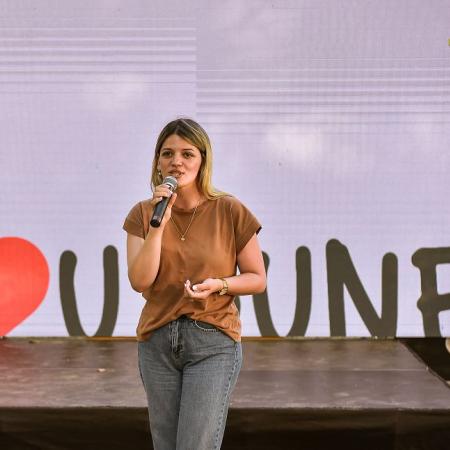
Samela Vata grew up in the small community of Velipoje, just minutes from the entrance to the protected landscape. From a young age she recognised the importance of the natural environment in her local area, and saw the beauty of the landscape beyond the popular beach tourism. She took part in local activities to protect and restore the landscape, including youth projects where local people directly restored and protected dune areas that are prone to erosion.
Samela has a vision to diversify people’s interest in the area and increase the perceived value of nature, especially through ecotourism. She successfully applied for a grant through the Living Buna small grant program, to develop activities in her ecotourism initiative, Farm 3B – Bed, Breakfast and Birdwatching, in Velipoje. The project is unique in the area, as the other offerings are heavily developed beachside areas, that cater for intensive activities and result in overcrowded beaches during summer, yet are completely deserted in the off-season.
The business provides accommodation and hire of equipment for passive recreation in nature – bikes, kayaks and hiking equipment. Samela and her family also offer guided activities to learn about the protected landscape. This type of tourism can be used all year round, reducing the issues of seasonality. Farm 3B also has a space available for presentations on nature conservation and meetings.
The business has room to grow, and importantly sets a model that can be considered in neighbouring communities.
When the final activity for our Buna youth engagement was held, a weekend long Buna Day Fair, Samela was able to be engaged to run a day of activities for youth in the protected area, and also to host staff with accommodation.
